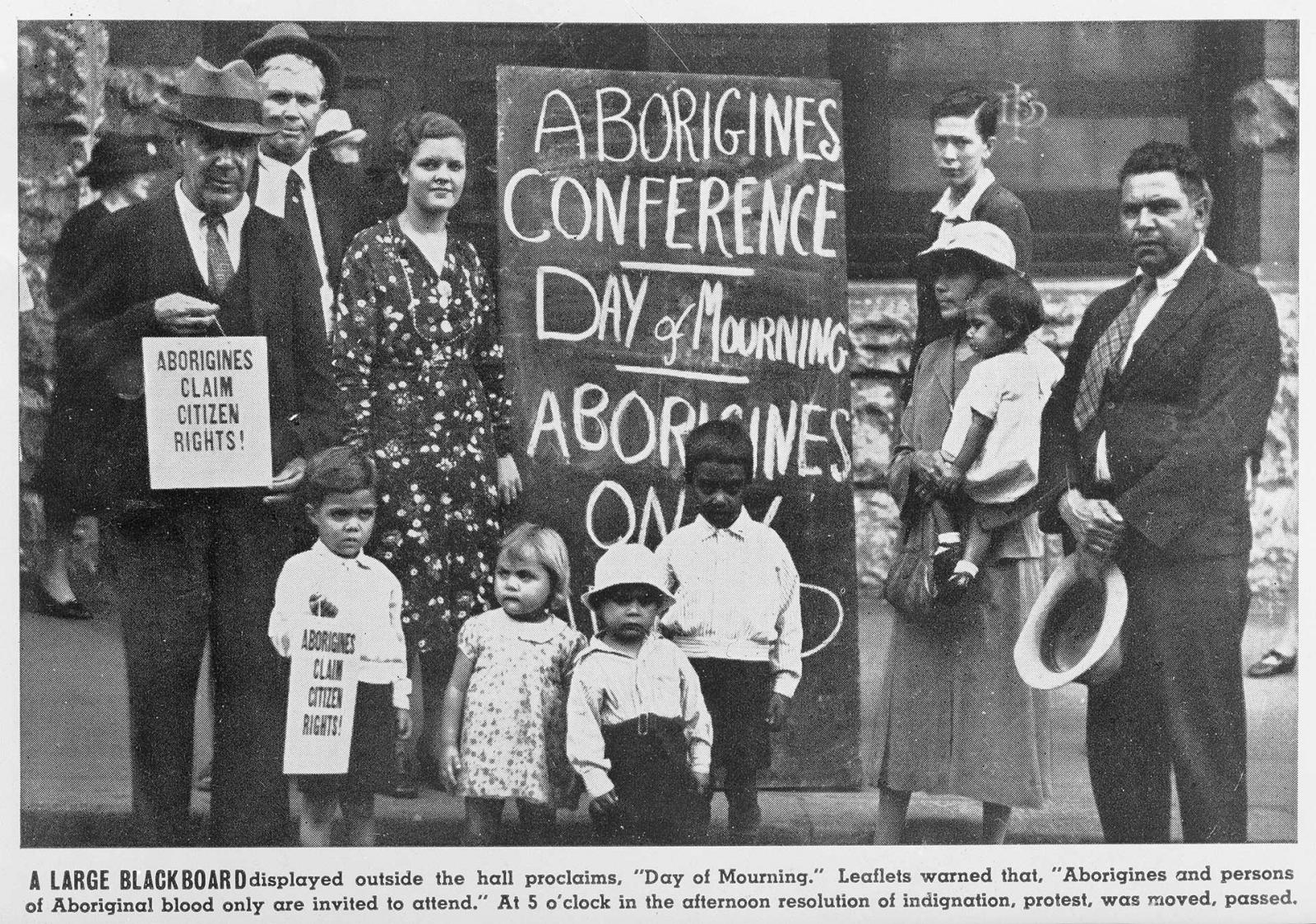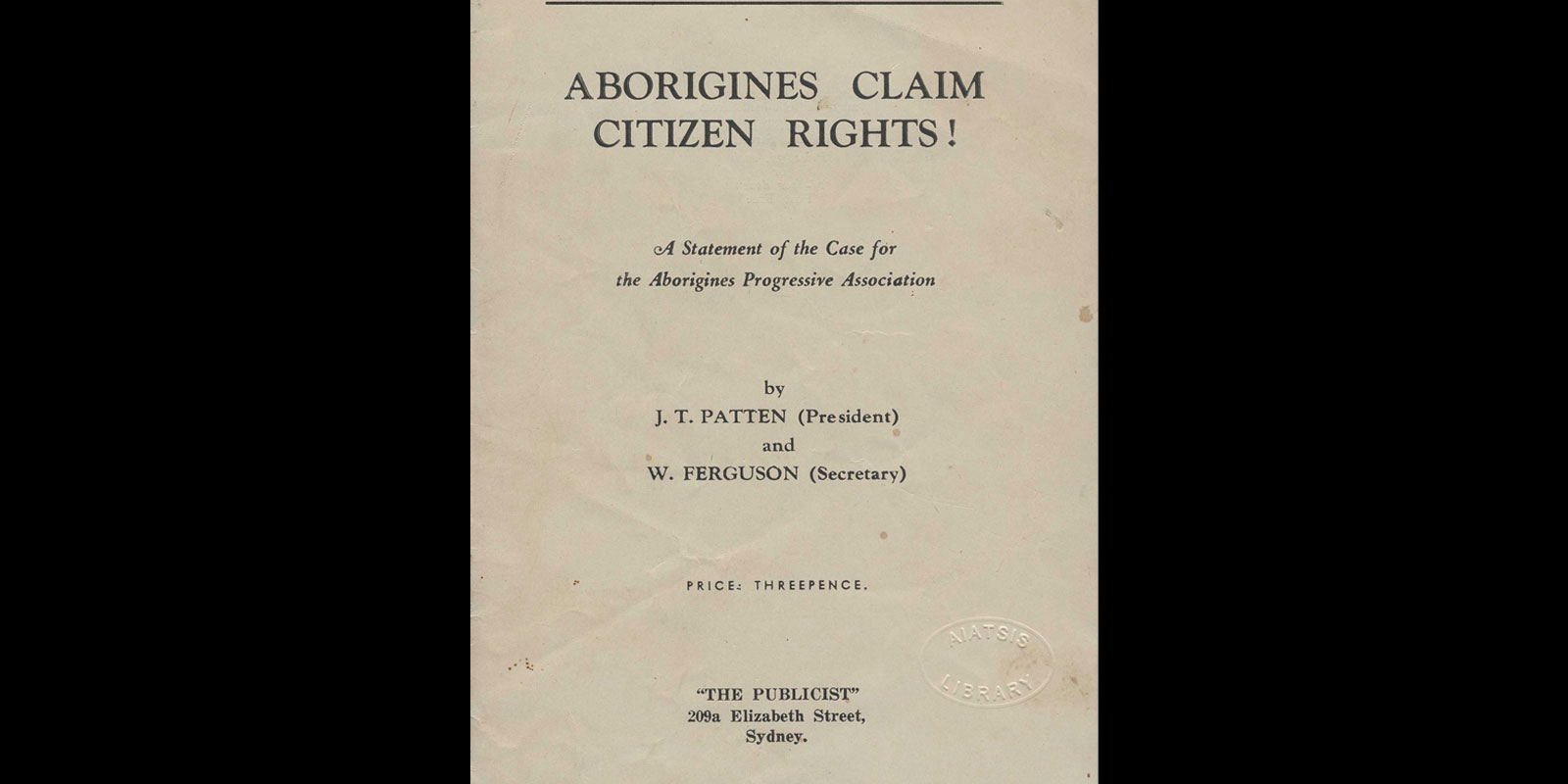A very significant protest in Aboriginal history was the 1938 Day of Mourning in Sydney.
On the 26th of January that year, many non-Aboriginal people were celebrating the 150th anniversary of the arrival of Europeans in Australia. Many Aboriginal people were outraged that their history and experiences were being ignored in these celebrations, so a protest was held on the same day to speak out against colonisation, theft of land and the treatment of Aboriginal people by Australian governments.
The Day of Mourning was organised by the Aboriginal Progressive Association (APA) of New South Wales with the support of the Aboriginal Advancement League in Victoria. Some of the key leaders involved in the protest included Uncle William Cooper, Pastor Doug Nicholls, Aunty Margaret Tucker and Aunty Pearl Gibbs.
The celebrations taking place in Sydney included a parade and a re-enactment of the landing of the First Fleet of ships bringing people from Britain to Australia. After the parade finished, over 1000 Aboriginal people and their supporters took part in a silent march through the streets of Sydney. Members of the APA wore black, despite it being a hot summer day, to symbolise that they were in mourning for Aboriginal lives lost and pain caused by colonisation.
Listen to Alick Jackomos discussing the Day of Mourning on the ABC's Right Wrongs resource.


Image: The first Day of Mourning, AIATSIS.
After the march, the APA, led by Uncle Jack Patten and Uncle William Ferguson, held a conference for Aboriginal people. They met to move the following resolution:
WE, representing THE ABORIGINES OF AUSTRALIA, assembled in conference at the Australian Hall, Sydney, on the 26th day of January, 1938, this being the 150th Anniversary of the Whiteman's seizure of our country, HEREBY MAKE PROTEST against the callous treatment of our people by the whitemen during the past 150 years, AND WE APPEAL to the Australian nation of today to make new laws for the education and care of Aborigines, we ask for a new policy which will raise our people TO FULL CITIZEN STATUS and EQUALITY WITHIN THE COMMUNITY.
Many who attended the conference made speeches calling for their rights to culture and land to be met.
Uncle Jack Patten addressed the conference, stating:
On this day the white people are rejoicing, but we, as Aborigines, have no reason to rejoice on Australia’s 150th birthday. Out purpose in meeting today is to bring home to the white people of Australia the frightful conditions in which the native Aborigines of this continent live. This land belonged to our forefathers 150 years ago, but today we are pushed further and further into the background.
Uncle William Ferguson spoke second, saying:
We have been waiting and waiting all of our lives for the white people of Australia to better our conditions, but we have waited in vain…Surely the time has come at last for us to do something for ourselves, and make ourselves heard. That is why the Aborigines Progressive Association has been formed.


Image: A statement of a case for the Aborigines Progressive Association, AIATSIS.
Pastor Doug Nichols then spoke on behalf of the Koorie Community in Victoria. He said:
The public does not realise what our people have suffered for 150 years. Aboriginal girls have been sent to Government Reserves and have not been given any opportunity to improve themselves. Their treatment has been disgusting …Now is our chance to have things altered. We must fight our very hardest in this cause.
The final speaker of the day was Aunty Pearl Gibbs. Her address to the conference is below:
Conditions on all the Aboriginal stations are a disgrace. They are all very much alike. At Brewarrina (in New South Wales) the children are taught by a man who is not a qualified teacher. Two old men on that station…are left by themselves in a half starved state. I spoke to these old men, and when they told me how badly they were treated it made me cry, and pray that this movement will be a success.
After the Day of Mourning, it was agreed that it should become a yearly event to continue to fight for the rights of our people. From 1940 to 1955, the Day of Mourning was held on the Sunday before Invasion or Survival Day.
After 1955, the day was moved to July and became a celebration of Aboriginal culture. The Committee that organised these celebrations was known as the National Aborigines Day Observance Committee (NADOC). In the 1990s, the Committee’s name changed to the National Aborigines and Islanders Day Observance Committee (NAIDOC). This became the name given for the whole week of celebrations.
Sources used in writing this article:
- Timeline: From the beginning of NAIDOC Week till now – NITV
- Day of Mourning - Australian Institute of Aboriginal and Torres Strait Islander Studies.
